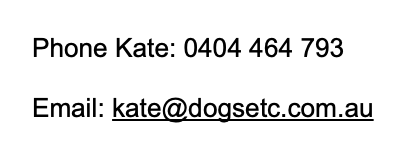My Requirements For Owner-Trainers That I Am Coaching
- Handlers under 18 require an adult to accompany them to all training sessions
- You need to have a disability as defined by the Disability Discrimination Act (1992) – simply having a disorder, medical problem or condition does not mean someone is disabled.
- You need to be aware that you may end up with a dog that can only help at home or in places pets are allowed
- You need to be willing to wait until I evaluate your dog’s suitability and help you train your dog in foundation skills, and obtain Third Party Public Liability insurance, before putting Assistance Dog identification on your dog and before taking your dog to places pets are not permitted.
- You need to have support from your licensed healthcare provider for use of an Assistance Dog.
- You need to help me to communicate with your healthcare professionals – this is important because the choice to use an Assistance Dog, and the selection of specific tasks, need to be appropriate and safe for the individual.
- You need to be self-funded as NDIS does not fund training an Assistance Dog or a Skilled Companion – training will typically cost between $5,000 and $10,000
How Does The Training Process Work?
The first stage of training an Assistance Dog is to teach the dog to be a well-behaved pet and companion, and I encourage all owner-trainers to engage my services on obtaining their puppy, to receive guidance and coaching through the critical developmental stages. Then if the dog still shows suitability, we can start more formal assistance dog training when the dog is emotionally mature enough, generally at around one year of age. From that point on, the emphasis becomes preparing the dog to work in Public Access, to take the Public Access Test (or demonstrate an equivalent standard of training), and to perform at least three trained Tasks to specifically aid the handler.
Training for an In-Home Only Assistance Dog
If you only need your dog to help you at home, or if your dog is not suited to Public Access, I can still help you train your dog, however your dog will not be an Assistance Dog with Public Access rights. Dogs that only help at home have no official recognition or rights, but may be called Skilled Companions, In-Home Only Assistance Dogs, or Home Support Dogs.
Where does the training take place?
I am based in O’Sullivan Beach, South Australia, and can meet clients at my private training studio, at their home if in southern suburbs, or at a suitable mutually agreed local public location when working on environmental exposure or Public Access preparation training. Remote sessions (phone or video call) are possible, from time to time, however I am unable to adequately assess a dog remotely.
Training Session Frequency
I recommend weekly or fortnightly training sessions, with the understanding that it can take 2-3 years for an Assistance Dog to reach the required standard (and assuming the dog has the right qualities)
Payment
Payment is on a “Pay-As-You-Go” basis. Lessons are charged individually – contact me for current rates. You are not locked into a contract and you do not pay upfront. This means that if for any reason you are wish to stop training with me (due to your health, or your dogs lack of suitability) you can stop at any time. You can pay in cash, with credit card, or by bank transfer.
NDIS
You need to be self-funded as NDIS does not fund training an Assistance Dog or a Skilled Companion. Until a dog reaches Assistance Dog Standard, it has no rights to Public Access and is simply a Pet. Pets are “not NDIS supports”. Training will typically cost between $5,000 and $10,000.

